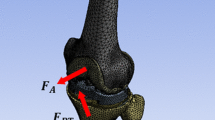Abstract
We previously combined experimental and computational measures to ascertain whether tibial stem augmentation reduces bone strains beneath constrained condylar implants. Using these same integrated approaches, we examined the benefit of a stem when a wedge is used. Implants were removed from the eight paired cadaver specimens from our previous experiment, and oblique defects created that were restored with 15° metallic wedges cemented in place. We applied a varus moment and an axial load and monitored relative motion between implant and bone. Specimen-specific 3-D finite element models were constructed from CT scans and radiographs to examine bone stress in the proximal tibia. Implants with a wedge but no stem had greater motion than the previous control with no stem or wedge. Use of a modular stem with a wedge maintained the same level of motion as the primary case, suggesting that a stem is preferable when a wedge is utilized. The computational models confirmed this conclusion with a 30% reduction in bone stress compared to 17% in the primary case without a wedge. The wedge carried more axial load compared to the primary implant due to its support on stiff metaphyseal bone.


Similar content being viewed by others
References
Altchek D, Sculco TP, Rawlins B. Autogenous bone grafting for severe angular deformity in total knee arthroplasty. J Arthroplasty. 1989;4:151–155.
Bartel DL, Burstein AH, Santavicca EA, Insall JN. Performance of the tibial component in total knee replacement. J Bone Joint Surg Am. 1982;64:1026–1033.
Brand MG, Daley RJ, Ewald FC, Scott RD. Tibial tray augmentation with modular metal wedges for tibial bone stock deficiency. Clin Orthop Relat Res. 1989;248:71–79.
Brooks PJ, Walker PS, Scott RD. Tibial component fixation in deficient tibial bone stock. Clin Orthop Relat Res. 1984;184:302–308.
Davy DT, Kotzar GM, Brown RH, Heiple KG, Goldberg VM, Heiple KG Jr, Berilla J, Burstein AH. Telemetric force measurements across the hip after total arthroplasty. J Bone Joint Surg Am. 1988;70:45–50.
Dorr LD, Boiardo RA. Technical considerations in total knee arthroplasty. Clin Orthop Relat Res. 1986;205:5–11.
Dorr LD, Ranawat CS, Sculco TA, McKaskill B, Orisek BS. Bone graft for tibial defects in total knee arthroplasty. Clin Orthop Relat Res. 1986;205:153–165.
Fehring TK, Odum S, Olekson C, Griffin WL, Mason B, McCoy TH. Stem fixation in revision total knee arthroplasty. Clin Orthop Relat Res. 2003;416:217–224.
Fehring TK, Peindl RD, Humble RS, Harrow ME, Frick SL. Modular tibial augmentations in total knee arthroplasty. Clin Orthop Relat Res. 1996;327:207–217.
Laskin RS. Total knee arthroplasty in the presence of large bony defects of the tibia and marked knee instability. Clin Orthop Relat Res. 1989;248:66–70.
Moeys EJ. Metal alloplasty of the knee joint: an experimental study. J Bone Joint Surg Am. 1954;36:363–367.
Nazarian DG, Mehta S, Booth RE Jr. A comparison of stemmed and unstemmed components in revision knee arthroplasty. Clin Orthop Relat Res. 2002;404:256–262.
Pagnano MW, Trousdale RT, Rand JA. Tibial wedge augmentation for bone deficiency in total knee arthroplasty: a followup study. Clin Orthop Relat Res. 1995;321:151–155.
Radnay CS, Scuderi GR. Management of bone loss. Clin Orthop Relat Res. 2006;446:83–92.
Rand JA. Bone deficiency in total knee arthroplasty: use of metal wedge augmentation. Clin Orthop Relat Res. 1991;271:63–71.
Rawlinson JL, Peters LE, Campbell DA, Windsor R, Wright TM, Bartel DL. Cancellous bone strains indicate efficacy of stem augments in constrained condylar knees. Clin Orthop Relat Res. 2005;440:107–116.
Ritter M. Screw and cement fixation of large defects in total knee arthroplasty. J Arthroplasty. 1986;1:125–129.
Scuderi GR, Insall JN, Haas SB, Becker-Fluegel MW, Windsor RE. Inlay autogenetic bone grafting of tibial defects in primary total knee arthroplasty. Clin Orthop Relat Res. 1989;248:93–97.
Windsor RE, Insall JN, Sculco TP. Bone grafting of tibial defects in primary and revision total knee arthroplasty. Clin Orthop Relat Res. 1986;205:132–137.
Author information
Authors and Affiliations
Corresponding author
Additional information
Each author certifies that he or she has no commercial associations (eg, consultancies, stock ownership, equity interest, patent/licensing arrangements, etc) that might pose a conflict of interest in connection with the submitted article.
The Clark and Kirby Foundations provided financial support.
Each author certifies that his or her institution either has waived or does not require approval for the human protocol for this investigation and that all investigations were conducted in conformity with ethical principles of research.
About this article
Cite this article
Rawlinson, J.J., Closkey, R.F., Davis, N. et al. Stemmed Implants Improve Stability in Augmented Constrained Condylar Knees. Clin Orthop Relat Res 466, 2639–2643 (2008). https://doi.org/10.1007/s11999-008-0424-z
Received:
Accepted:
Published:
Issue Date:
DOI: https://doi.org/10.1007/s11999-008-0424-z




